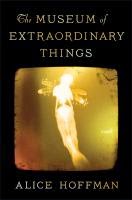Outsiders finding their place in society: that's a theme I love. There are misfits of all kinds in Alice Hoffman's The Museum of Extraordinary Things.
The two central characters are Ezekiel, who was a child when he and his father escaped a pogrom in Russia and made their way to New York City, and Coralie, who has webbed fingers. Coralie's father has made her a part of his freak show exhibit on Coney Island. The main story takes place in 1911.
The narrative alternates between Coralie and Ezekiel, who sheds his Jewish identity and goes by the name Eddie when he becomes a photographer. Each time the narrative shifts, it begins with 15-20 pages in first person, like a journal entry, then switches to third person. In the US edition that I read (Scribner 2014), all of the journal entry text is in italics. Dense pages and pages of it. So hard on the eyes. I sighed every time I got to another section like that.
Fortunately, the plot is compelling. Other hooks for me include the Triangle Shirtwaist Factory fire, the struggles of early labour organizers, mention of Alfred Stieglitz, and details about early photographic techniques.
The following passage intrigued me because I agree with the first part, but not the part about the ability of a camera to capture truth. A photo cannot provide context, and a photographer chooses what to include in the frame.
"Eddie had come to understand that what a man saw and what actually existed in the natural world often were contradictory. The human eye was not capable of true sight, for it was constrained by its own humanness, clouded by regret, and opinion, and faith. Whatever was witnessed in the real world was unknowable in real time. It was the eye of the camera that captured the world as it truly was. For this reason photography was not only Eddie's profession, it was his calling."
Coralie was already a sympathetic character, and then I loved her more when I discovered that she and I had similar reactions to Jane Eyre:
"If the wolfman had not disappeared from my life I would have made certain to question him further about Jane Eyre, the book he held so dear to his heart. I suppose I was studying love, and in my studies of this subject I could never understand the brutal love of Rochester. I did grasp why Rochester revealed his humanity only after he had been blinded and disfigured; like the beasts around us who reveal their natures because they have no access to artifice, he at last had no choice but to be truly himself. I wondered why he didn't then realize how cruelly he'd treated the first Mrs. Rochester. Surely if he comprehended all he'd done to her, he would have locked himself in a tower to repent for the rest of his days rather than taking the sweet Jane as his wife.
As for Jane, I considered her to be a fool, but what young woman has not been a fool under certain circumstances?"
Another bookish connection comes in the form of a garment factory worker named Hannah, who kept a spool of blue thread in her pocket for luck. It made me wonder if there is a particular backstory or symbolism related to this object, because Anne Tyler's latest novel (which I have yet to read) is called A Spool of Blue Thread.
The Museum of Extraordinary Things stretches credibility too often, especially in the resolution. I was annoyed by inconsistencies like when Bonavita, an animal trainer with only one arm, clapped his hands to direct a lion. Still, its good qualities outweigh its faults. It prompted a wide-ranging discussion at my book club.
A perfect companion read is a haunting historical graphic novel featuring a mermaid in the Hudson River: Sailor Twain (Mark Siegel).



No comments:
Post a Comment